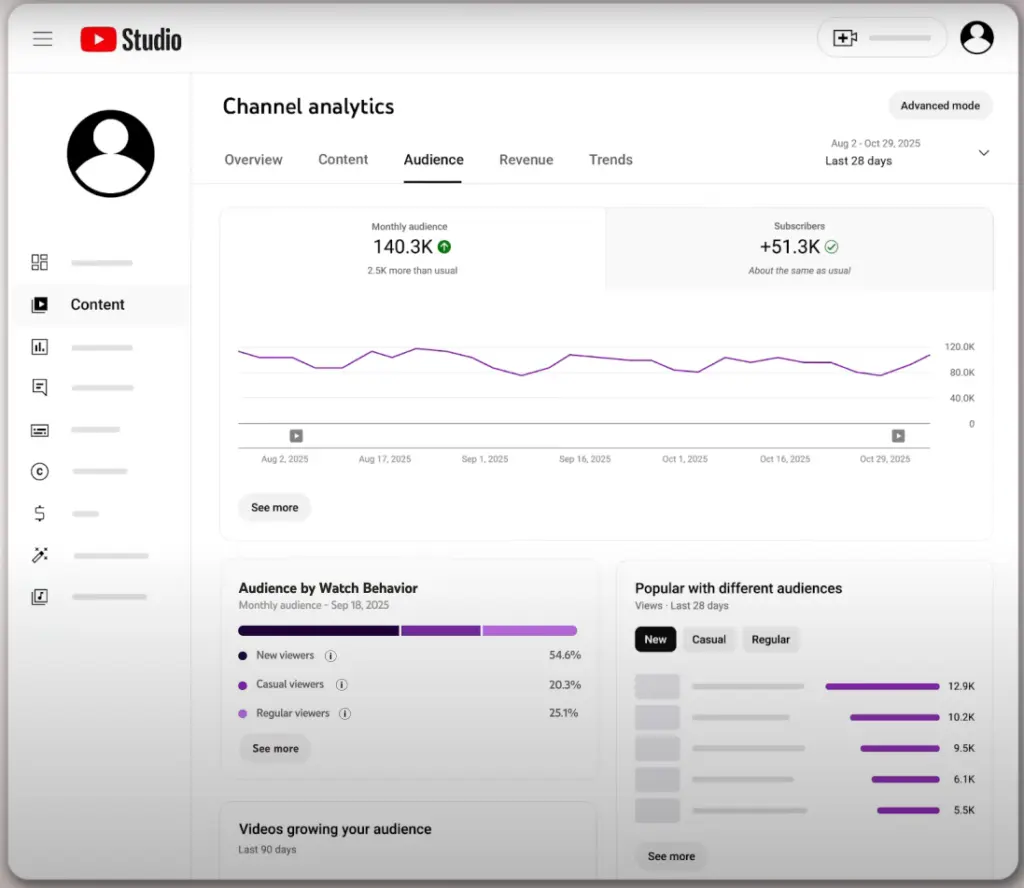- Nuanced Segmentation: YouTube now splits audiences into new, casual, and regular viewers, replacing the limited “returning viewers” metric.
- Enhanced Insights: This richer data reveals not just who comes back, but how frequently, enabling smarter content and community strategies.
- Actionable Guidance: Creators can use these categories to improve publishing consistency, spark interactive conversations, and convert casual watchers into devoted fans.
- Brand Impact: Marketers gain clearer benchmarks for loyalty when choosing creator partners, prioritizing sustained engagement over one-off reach.
- Analytics Evolution: YouTube’s move underscores a broader trend toward valuing depth of connection, setting the stage for future refinements in audience intelligence.
YouTube’s shift from “returning viewers” to nuanced audience tiers arms creators with deeper insights into their channel’s heartbeat.
For years, creators on YouTube gauged their success by a simple breakdown: fresh faces versus returning viewers. That dichotomy painted only part of the picture, often obscuring the true nature of audience commitment.
Now, YouTube is replacing this binary lens with a spectrum of viewer categories, offering creators a clearer window into the rhythms of their community. Rather than simply knowing who has clicked before, channel managers can discern who’s dipping their toes in for the first time, who drops by occasionally, and who sticks around for the long haul.
This transformation in analytics promises to reshape how videos are planned, how fans are nurtured, and ultimately how channels grow sustainably over time.
Rethinking “Returning”
In the past, any viewer who reappeared after their inaugural watch was tagged as a “returning viewer,” regardless of whether that return was once in half a year or every week. This approach treated casual glimpses and unwavering loyalty as indistinguishable acts, making it difficult for creators to focus their efforts.
The revamped system, however, introduces three distinct audience tiers—new, casual, and regular—that reflect varying levels of commitment. By moving away from the catch-all category, YouTube acknowledges that not all repeat views are created equal.
This evolution invites creators to shift from chasing raw rewatch numbers to fostering genuine connections with their most engaged supporters.
Unpacking the Viewer Tiers
The new segmentation framework begins with “new” viewers, those experiencing a channel for the very first time in a given window. They represent potential growth, responding to discovery algorithms or word-of-mouth recommendations.
Next comes the “casual” segment, composed of individuals who return sporadically enough to suggest genuine interest but not quite habit. Finally, the “regular” viewers form the bedrock of any channel, tuning in consistently and often serving as brand ambassadors in comments, shares, and live interactions.
These distinctions not only offer a refined understanding of audience behavior but also empower creators to tailor outreach, sparking curiosity in newcomers, deepening engagement with casual watchers, and rewarding the faith of devoted fans.

Source: YouTube
Turning Insights into Strategy
Armed with this richer data, creators can craft more intentional content journeys. For those seeking to convert newcomers into casual viewers, beginning each upload with context-setting introductions and welcoming calls to subscribe can help cement initial interest.
Casual audiences, meanwhile, benefit from interactive features, such as community polls or short-form updates between uploads, that remind them why they first clicked in the first place. To honor regular viewers, creators might host exclusive live premieres or foster behind-the-scenes glimpses that reward loyalty.
In all cases, genuine dialogue, replying to comments, spotlighting viewer suggestions, and creating shared rituals around new releases become the engine that propels viewers from passive consumption to active participation.
Implications for Partnerships and Sponsorships
For brands and agencies, these nuanced metrics offer a fresh lens on influencer partnerships. Advertisers no longer must rely solely on overall subscriber counts or broad engagement snapshots; they can hone in on channels that demonstrate authentically engaged communities.
A creator whose audience skews heavily toward regular viewers signals a tribe of invested fans who are likely to absorb and act on sponsored messages. Conversely, a channel with a large but largely casual following might shine in high-visibility launch campaigns but prove less potent for long-term brand affinity.
As marketers increasingly value meaningful interactions over fleeting impressions, this richer analytics palette equips them to choose collaborators whose audiences align with campaign goals.
Looking Ahead: The Future of Creator Analytics
This pivot toward audience loyalty metrics is only the beginning of YouTube’s analytics evolution. As the platform continues to refine its tools, we may soon see even more granular insights—such as viewer sentiment trends or cross-channel engagement patterns—that deepen creators’ understanding of their communities.
Longer-term, machine-learning enhancements could surface predictive signals, alerting creators when casual viewers are on the brink of deepening their connection or when regular viewers may be drifting away. Ultimately, YouTube’s investment in audience intelligence underscores a broader shift across the creator economy: success is measured not by momentary virality but by the ongoing exchange between storyteller and spectator.



